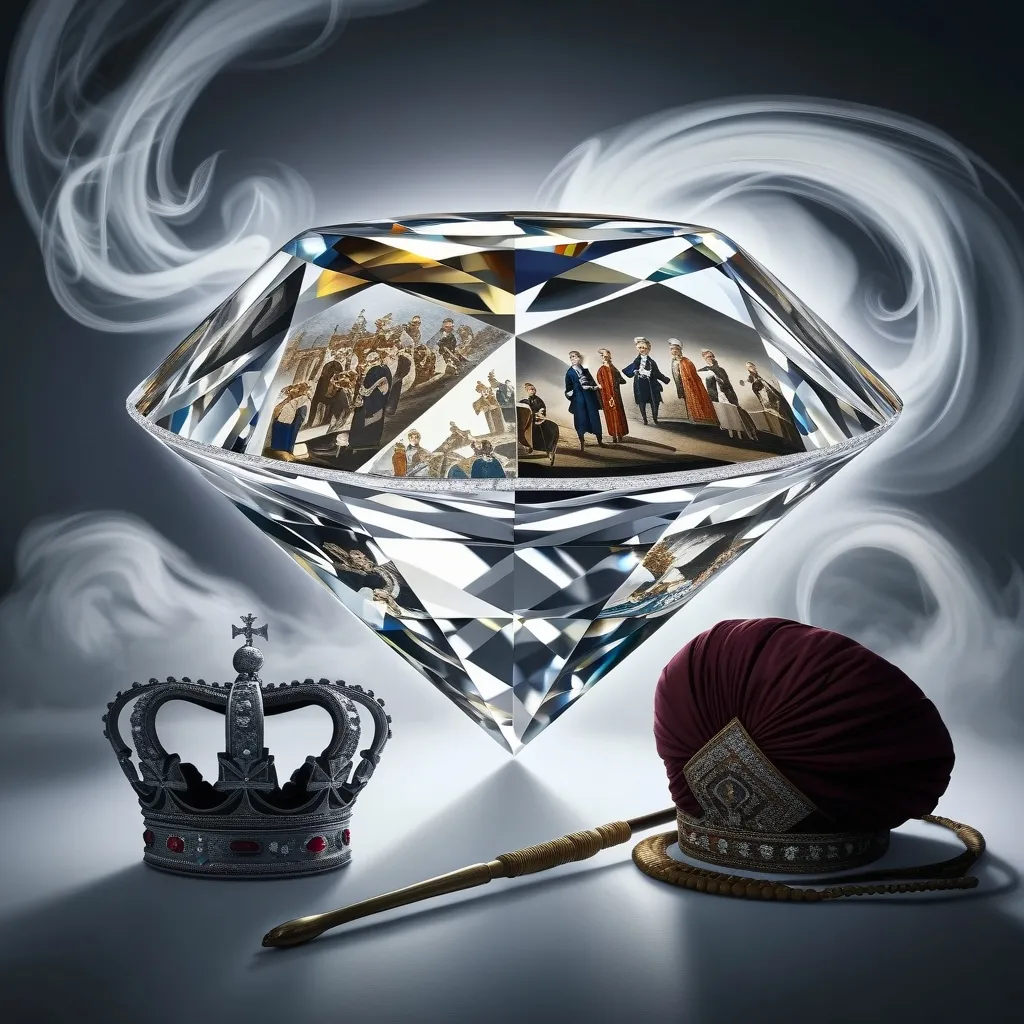The Koh-i-Noor: A Gem’s Journey Through Power, Curses, and Controversy
Ever heard of a diamond that’s said to bring bad luck to its male owners? Well, buckle up, because we’re about to dive into the fascinating world of the Koh-i-Noor, one of history’s most infamous gems. This isn’t just any old rock – it’s a diamond with a story that’ll make your head spin!
Let’s start at the beginning, shall we? The Koh-i-Noor, which means “Mountain of Light” in Persian, is believed to have been discovered in India’s Kollur Mines. Now, imagine finding a diamond so spectacular that rulers would literally fight wars over it. That’s the Koh-i-Noor for you!
The earliest reliable mention of this beauty dates back to the 13th century. It was bouncing around between different Indian dynasties, each ruler thinking they’d hit the jackpot by possessing it. Little did they know, right?
Now, here’s where things get spooky. According to legend, the Koh-i-Noor carries a curse that brings misfortune to any male ruler who dares to claim it. Talk about high-stakes jewelry! This curse is rooted in Hindu texts, which state that only God or a woman can wear the diamond without facing dire consequences. It’s like the ultimate “look but don’t touch” warning.
Throughout history, the Koh-i-Noor has seen more drama than a soap opera. It’s passed through the hands of numerous rulers, and let’s just say things didn’t end well for most of them. We’re talking murders, power struggles, and the fall of entire dynasties. It’s like this diamond had a VIP pass to all the major historical events!
Take the Persian ruler Nadir Shah, for example. He got his hands on the Koh-i-Noor in 1739, probably thinking he’d scored big time. But guess what? He was murdered soon after. Coincidence? The curse believers would say absolutely not!
Now, let’s fast forward to the British getting involved. After the Anglo-Sikh Wars in the mid-19th century, the British East India Company basically strong-armed the young Sikh ruler, Duleep Singh, into “gifting” the Koh-i-Noor to Queen Victoria in 1849. Talk about a forced gift! This wasn’t just about getting a shiny new toy for the Queen – it was a power move, a way for the British to flex their colonial muscles.
Since then, the Koh-i-Noor has been living it up in the UK, but with a twist. It’s only been worn by female members of the British royal family. Queen Victoria rocked it in a brooch and a circlet, and later it found its way into the crowns of Queen Alexandra, Queen Mary, and Queen Elizabeth The Queen Mother. Is this a fashion choice or a clever way to dodge the curse? You decide!
But hold onto your hats, folks, because the curse drama isn’t over yet. Recently, there’s been a buzz about King Charles III’s cancer diagnosis. Now, he didn’t wear the Koh-i-Noor during his coronation (smart move?), opting instead for a crown with the Cullinan II diamond. But some people are still wondering if the curse is at play. And with his daughter-in-law, Kate Middleton, also undergoing cancer treatment, the rumor mill is working overtime.
Let’s take a moment to appreciate how this diamond has been a chameleon of cultural symbols. In South Asia, it was all about masculinity and power – rulers would wear it on their turbans or arms to show off their divine right to rule. But when it crossed over to Britain, it got a makeover. Suddenly, it was a girl’s best friend, used to emphasize Queen Victoria’s femininity. Talk about a culture shock for a diamond!
This shift is pretty fascinating when you think about it. It’s like the Koh-i-Noor went through a whole identity crisis, changing from a symbol of masculine power to a feminine accessory. It just goes to show how objects can take on completely different meanings depending on who’s wearing them and where.
Now, let’s address the elephant in the room – the controversy. The Koh-i-Noor isn’t just sitting pretty in the British Crown jewels without raising a few eyebrows. There are plenty of voices calling for its return to India. It’s become a symbol of the complex and often painful history of colonialism. But for now, it’s staying put, continuing to captivate imaginations and stir up debates.
So, what do we make of all this? Is the Koh-i-Noor really cursed, or is it just a victim of its own hype? Whether you believe in the curse or not, you can’t deny that this diamond has seen more action than most of us ever will. It’s been at the center of wars, colonialism, and enough royal drama to fill a Netflix series.
The story of the Koh-i-Noor is like a crash course in world history, packed into one sparkling gem. It’s a reminder that objects can carry immense symbolic power, sometimes far beyond their material value. This diamond has been a player in some of history’s biggest power games, and its story is far from over.
In the end, whether you see the Koh-i-Noor as a cursed object, a stolen treasure, or just a really impressive rock, its tale is undeniably captivating. It’s a testament to how myths and legends can shape our perception of reality. And let’s be honest, it’s also a great conversation starter at parties!
As we continue to be fascinated by the Koh-i-Noor, it’s worth reflecting on the complex history behind many of our world’s treasures. Sometimes, the most valuable things come with the heaviest baggage. The Koh-i-Noor isn’t just a diamond – it’s a time capsule, a political hot potato, and a mirror reflecting centuries of human ambition, conflict, and mystique.
So, next time you’re daydreaming about owning a famous diamond, maybe think twice. If the Koh-i-Noor’s story teaches us anything, it’s that some bling comes with strings attached – and possibly a curse or two! But hey, at least it makes for one heck of a story, right?






